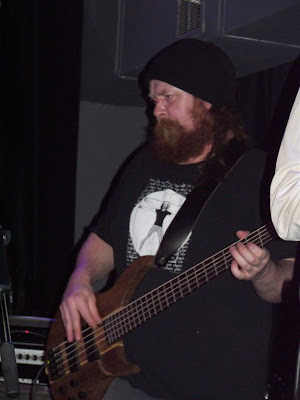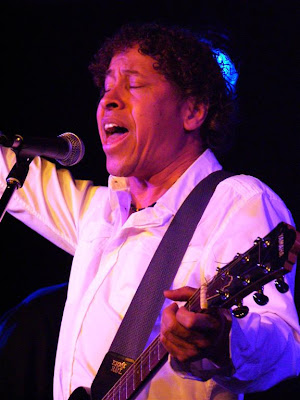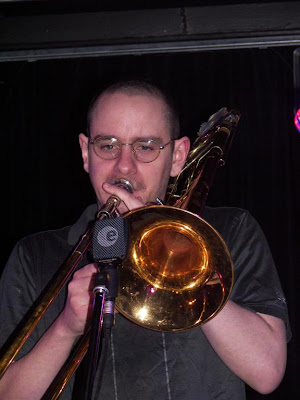All other writers retain their own copyright.
Links to articles follow each pieceHere are some recent sightings of your FFanzeen
publisher on the Web (marked in bold in the piece). Note that I have not edited the text of the pieces, so all materials are as they were in the originals.
First up is a blog by Walter Ocner, who has been a good friend for decades. A record collector for years, he only just started blogging recently. Hopefully, he’ll continue with some longer (i.e., more than a couple of paragraphs) pieces like this one. Hi, Sandra!1.
Why I Love Records Stores – Rockit Scientist and Rebel Rebel in NYC, by Walter OcnerI always loved collecting. When I was a kid I really got into coins and used to read magazines about them and tried hard to collect V nickels and Morgan silver dollars. There was a precious metals store a few blocks away I used to go to after school and pick up indian head pennies and whatever else I could afford. I would buy magazines like Coins and Coin Collecting and salivate at the thought of one day owning a $20 gold piece. Unfortunately my meager savings couldn’t keep me in the hobby I was so passionate about and eventually I began to lose interest. You just can’t sustain a hobby on wishing alone.
As i got older, music became my passion. I guess you could say everything else fell by the wayside, like school. This was during the days of vinyl when You could go into any music store and flip through the bins of new and import LP’s. I used to go to a few neighborhood stores in Queens such as Numbers Records or The Record Room. I would pick up singles for 99 cents by The Beatles, Icicle Works, Rod Stewart or The Smiths. They usually came with cool picture sleeves which made you want to take a chance on hearing the music inside.
Manhattan was a goldmine for new and used records. For me, it wasn’t just about enjoying the music but the treasure hunt aspect of collecting. I used to dream of finding rare British pressings of Beatle albums or bootlegs with unreleased material. My collection grew, much to the ire of my parents who proclaimed it a waste of money. Every cent I had went to records. I can’t blame them for being so angry, they were struggling to support a family and here I was, blowing all my cash on vinyl.
I have a huge record collection now. My friend
Robert Francos (Editor of
FFanzeen) once told me when we were in his room, which looked like a record store, that one day I would have a collection like his. I thought he was nuts and now, I probably have more than he does. I still love the hunt, the search for the elusive gem. Two of my favorite places to shop are in Manhattan, Rockit Scientist Records at 33 St. Marks Place and Rebel Rebel on 319 Bleecker Street. Both John and Dave run amazing shops that are brimming with reasonably priced goodies.
The thing I love about going there is what I don’t get from buying online from Amazon or whatever. That is the personal touch and the sense of discovery. You walk in and something will catch your eye or ear. John at Rockit Scientist and Dave at Rebel will play you things based on your musical taste. They will engage you in discussion and help you discover groups and albums you never would have found on your own. I might find music cheaper online, but I would rather pay a bit more and keep the independent record store alive and give me a place to discover and learn about music. These are the best stores around and cannot be replaced by an impersonal online retailer. You will find things here you will never find at a WalMart, so in essence, you are also keeping independent labels and bands alive and thriving as well.
I urge all of you to visit these guys and the “mom and pop” stores in your neighborhoods. You will make new friends and discover a world of exciting culture that will enrich your life!
http://walterocner.wordpress.com/2009/06/03/why-i-love-records-stores-rockit-scientist-and-rebel-rebel-in-nyc/* * *
Next is AC/DC Machine, a Swedish metal webzine. The interview was run by Niclas Müller. Here he Q&A’s the publisher of a new book about the band which contains photos I took of AC/DC at CBGBs in 1977. 2.
Intervju med Dennis PernuDetta är en komplettering till intervjun som Niclas Müller Hansen gjorde med Phil Sutcliffe. Här pratar de om arbetet bakom AC/DC boken, High Voltage Rock'n'Roll: The Ultimate Illustrated History.
Where did you get the idea for this kind of AC/DC book? We had published Whole Lotta Led Zeppelin (2008) and Queen: The Ultimate Illustrated History (2009), both of which were well-received. Ever since, we’ve been constantly casting about for other bands and artists with long, engaging histories and rabid worldwide followings. AC/DC seemed to fit the bill, and so far that hunch has proven correct.
How long did it take to put together?Just about a year, from the time I asked Phil if he was interested in writing the main narrative to the day we had finished books sitting in our warehouse! Ideally we’d have more time to put books like this together, but because our music publishing program was still relatively young at the time, we were still getting up to speed on getting books into the marketplace.
Did you know of Bill Voccia before this project or any of the other ones involved in the book?I did not know Bill before beginning this project but was fortunate to find him and have him agree to get involved. You’ll notice a lot of the more interesting items depicted in the book come from his vast collection. A few of the other writers and photographers featured in the book had contributed to previous projects, notably Detroit-based photographer Rob Alford, Garth Cartwright (who penned the piece exploring AC/DC’s brief dalliance with the world of punk rock), Dave Hunter (who wrote the sidebar on Malcolm and Angus’s gear and who also wrote a stellar book for us last year called Star Guitars), Andrew Earles (who contributed to the Zep and Queen books but also wrote a full-length narrative history about Hüsker Dü, which we also published last year). Let’s see . . . Gary Graff has also written pieces for us in the past (he gathered all those great musician quotes on the endpapers), as has Sylvie Simmons. Other than that, I tried to target writers who I felt were considered some of the world’s top scribes in the realms of hard rock, heavy metal, and AC/DC—guys like Ian Christe, Daniel Bukszpan, Martin Popoff, Joe Bonomo, Anthony Bozza—and photographers like Robert Ellis, Philip Morris, and Bob King who had iconic images of the band. Happily, I was able to agree to terms with all of them.
How did you go about picking out the items featured in the book?Believe it or not, aside from Voccia’s items, the bulk of the memorabilia was the result of 4 or 5 months of scouring eBay on a daily basis.
Tell us about the "spinning Angus cover"!Whenever we decide to publish a book we have a preliminary meeting to discuss possible cover concepts. I had already seen Rob Alford’s photo of Angus spinning on the stage at the 1979 World Series of Rock and half-jokingly suggested we incorporate an actual spinner to assimilate Angus’s famous stage antics. At the time I got the impression that most of the room thought I was nuts. But the person who managed the book’s design process and the person who arranges for the manufacturing of our books took up the idea and ran with it. When everyone else saw that they were pursuing it and that it was actually possible, it just took on a life of its own. I think it really captures the manic energy of the music in a way a static photo can’t. The spinner is also a bit goofy, just like Angus’s stage performances. “Goofy” in a good way, of course. It’s interesting, my 6-year-old son and I just saw School of Rock and Jack Black’s character shows his students footage of Angus spinning on stage. My son thought it was hilarious. It really speaks to the band that they can appeal to rock fans from ages 6 to 60.
Was there a lot of cool stuff that didn’t end up in the book? Arnaud Durieux has a mind-bending gigography that I wanted to license for the book, but he respectfully declined, citing his own future book project. Other than that, one of the main problems with assembling these books is that usually a day or two after it goes to press you stumble upon a killer piece of memorabilia or photo that you missed or that wasn’t available when you were gathering materials.
How did you get Phil Sutcliffe involved?Phil penned the main narrative of our aforementioned Queen book. He was such a pro’s pro on that project, and I was aware of his old Sounds review of a 1976 AC/DC show at the Marquee in London, so I asked him if he wanted to write this one. I think the fact that all these people whom I badly wanted to be involved with the book agreed to it speaks to how much people really love this band.
Tell us about your first AC/DC show? How many times have you seen them live? Unfortunately, I’ve never seen the band live! The thing I realized about AC/DC while putting this book together is that they were always pigeonholed in the States as a metal band, which of course they’re not . . . they’re just a loud, fast rock ’n’ roll band. But that categorization turned me off when I was younger, even though I’d heard a lot of their stuff. So as someone who came of age listening to bands like the Replacements in the ’80s and then going to tons of club shows in the ’90s (Soul Asylum, Mudhoney, Rev. Horton Heat, Run Westy Run, the Cows, Dinosaur Jr., Sonic Youth, the Jayhawks, Wilco, etc.), I was too doctrinaire to go back and explore AC/DC, because, well, the ’80s and even the early ’90s weren’t altogether kind to them and they were considered dinosaurs. I regret not getting to know them earlier. Despite the “indie rock” ethos that I bought into, AC/DC were clearly a band that paid their dues and that even influenced, to varying degrees, the bands I was listening to.
Favorite AC/DC item in the book and why? That’s a tough one. The spread of silkscreened Black Ice tour posters is cool, but I would have to say that a handful of photos are my favorites, particularly
Robert Francos's CBGB photos and Jenny Lens’s Whisky A Go Go shots (check out Jenny’s image showing Angus’s sweat-drenched SG). I mean, who doesn’t wish they saw AC/DC in a small rock club? Also, there are a couple of two-page spreads showing crowds at the Apollo Theater in Glasgow and at Monsters of Rock, which I love. And, the Rob Alford shot on page 88. You always read about the prodigious amounts of snot that would fly from Angus’s nose at shows. Here, you can actually see the boogers in his nose!
Favorite AC/DC record and why? Ooh, another difficult one! I’d have to say the High Voltage (the Atlantic debut)—the LP that introduced the band to the rest of the world. It’s just tight, blues-based rock full of Bon’s trademark wit. Plus Rolling Stone called it an “all-time low” for hard rock, so the boys had to be doing something right. I wish they’d included their version of “Baby, Please Don’t Go.” Seems just about everyone’s covered the song, but I don’t think anyone’s surpassed AC/DC’s take. Budgie and Lightning Hopkins came close. . .
Any other projects going on? Speaking of “Baby, Please Don’t Go,” we have a similar treatment of Aerosmith due in September (written by Guitar World executive editor Rich Bienstock), and Iron Maiden coming next spring (by UK-based metal journo Neil Daniels).
www.acdcmachine.com/files/interview_dennispernu.php* * *
Wow, this was on the Huffington Report Blog page. It also appeared in a number of other sites, a couple of which I’ve listed at the bottom of the article. It, again, pertains to Phil Sutcliffe’s “High Voltage Rock'n'roll” 3.
Mike Ragogna HuffPost Reviews ACDC Email
Written by bestsellerelectronic on Dec-19-10 9:00pm
From: bestsellerelectronic.com
So, you consider you know all things AC/DC? Really. Well, take a hit of the essays, chronological photos, memorabilia, and ubiquitous profusion contained in in between the over 225 pages of High Voltage Stone 'N' Roll: The Ultimate Illustrated History and you'll be intimidated indeed. Stone edition residence Phil Sutcliffe (with a small assistance in sidebar form from folks similar to Robert Ellis, Joe Bonomo, Philip Morris, and a expel of 17 others) reserve the biographical and chronological grit which takes us from Angus & Malcom Young's prophesy by the Brian Johnson and Chris Slade register adjustments and, of course, way beyond. Commentaries and reflections by Jimmy Page, Billy Gibbons, Joe Perry, Steve Vai, Ace Frehley, Meat Loaf, Jack Johnson (yes, Jack Johnson), and Joe Elliott spin out the over-the-top jubilee which is Illustrated History. A small of the early shots of the rope by Philip Morris and Bob King are value the cost of the book alone. But add bar cinema by Jenny Lens and
Robert Francos and the behind-the-scenes images contributed by Robert Ellis and Robert Alford, and you have a visible story which is as current as any of the authors' contributions or researchers' timelines and discography. Who knew there was so many to know about this steel antecedent from Australia, one which many dont consider about contributed to the tough stone theatre in the U.S. some-more than many American bands did. Now you know, and the rest, as they say, is Illustrated History.
http://www.zimbio.com/Chip+Taylor/articles/38VMKfSRbA4/Mike+Ragogna+HuffPost+Reviews+ACDC+Jane+Roman
Also appeared on:
legal-sleaze.com
allword-news.co.uk/tag/pete-finney
thoughtandword.com/rss/author/Mike
* * *
Thus Spoke the Spectacle is a multi-media performance focused on the
way mass media is used against it’s audiences, or at the very least, for their own purposes. Much of it is focused on the material of Marshall McLuhan, Neil Postman and Jacques Ellul. I had the pleasure to see it a few times, and took photos that they used on their Website.4. Thanks to the MEA organizers who invited us to perform, including Sara van den Berg, Paul Soukup, Janet Sternberg, and Lance Strate. Special thanks to Abigail Lambke and Dan Frierdich for securing a great performance space and managing all the tech issues;
Robert Francos for his many excellent photographs; and all of our MEA friends and supporters for making this performance of Thus Spoke The Spectacle truly one to remember.
http://www.thespectacle.net/blog/2009/06/* * *
The Echoes are a fun band whose CDs I had the pleasure to review for my Jersey Beat
column, “The Quiet Corner.” The Echoes’ response was nice to read. 5.
The Echoes Official Website The 2007 Release Of "NOW HEAR THIS" Having Stimulated A New Interest In 2005's "LISTEN UP... IT'S THE ECHOES," Famed Music Critic
ROBERT BARRY FRANCOS Wrote The Following REVIEW For The Spring 2008 Edition Of JERSEY BEAT:
"Kentucky-bred and New York based, THE ECHOES are a twosome who have released "LISTEN UP... IT'S THE ECHOES," which is available at theechoesofficalwebsite.com. They sing in a folk style reminiscent of Ian & Sylvia, and give us all original tunes written by Mark Alexander, though most of the lead singing is (wisely) handled by Teresa Starr. The songs are full of love and tenderness, with Starr's high voice and Alexander's supporting guitar and voice (he does sing a lead here and there). This is definitely an easy listen on many levels, including a joyful melody line and a to-the-point lyrics structure ("I met you just the other day/You made it in my dreams that night" are the CD's opening lines, from "IF I DO"). This is the folk equivalent of lite jazz, and I don't mean that as an insult; it's a style that is very listener friendly. Like cocoa and a blanket on a chilly evening." --
Robert Barry Francos, JERSEY BEAT, Quiet Corner
THE ECHOES Would Like To Thank
ROBERT BARRY FRANCOS & JERSEY BEAT For Their Support !!!
http://theechoesofficialwebsite.com/echonews.html





























































